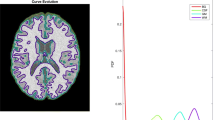Abstract
We present a new brain segmentation framework which we apply to T1-weighted magnetic resonance image segmentation. The innovation of the algorithm in comparison to the state-of-the-art of non-supervised brain segmentation is twofold. First, the algorithm is entirely non-parametric and non-supervised. We can therefore enhance the classically used gray level information of the images by other features which do not fulfill the parametric Gaussian assumption. This is illustrated by a segmentation algorithm that considers both, voxel intensities and voxel gradients for the segmentation task. The resulting algorithm is called a non-supervised, non-parametric hidden Markov random field segmentation. Furthermore we have also to construct an anatomically relevant segmentation model in the resulting two-dimensional feature space. This is the second main contribution of this paper. We construct a morphologically inspired classification model, which is also able to segment the deep structures of the brain into a separate class, resulting in a six class segmentation model. We prove the validity of the introduced mathematical and morphological aspects on simulated T1-weighted magnetic resonance images of the brain.
Chapter PDF
Similar content being viewed by others
Keywords
These keywords were added by machine and not by the authors. This process is experimental and the keywords may be updated as the learning algorithm improves.
References
Wells III, W.M., Grimson, W.E.L., Kikinis, R., Jolesz, F.A.: Adaptive segmentation of MRI data. IEEE Transactions on Medical Imaging 15(4), 429–442 (1996)
Zhang, Y., Brady, M., Smith, S.: Segmentation of brain MR images through a hidden Markov random field model and the expectation-maximization algorithm. IEEE Transactions on Medical Imaging 20(1), 45–57 (2001)
Shattuck, D.W., Sandor-Leahy, S.R., Schaper, K.A., Rottenburg, D.A., Leahy, R.M.: Magnetic resonance image tissue classification using a part ial volume model. Neuro Image 13, 856–876 (2001)
Besag, J.: Spatial interaction and the statistical analysis of lattice systems. Journal of Royal Statistical Society 36(2), 192–236 (1974)
Geman, S., Geman, D.: Stochastic relaxation, gibbs distributions, and the bayesia n restoration of images. IEEE Transactions on Pattern Analysis and Machine Intelligence 6(6), 721–741 (1984)
Santago, P., Gage, H.D.: Quantification of MR brain images by mixture density and partial volume modeling. IEEE Transactions on Medical Imaging 12(3), 566–574 (1993)
Kwan, R.K.-S., Evans, A.C., Pike, G.B.: MRI simulation-based evaluation of image-processing and classification methods. IEEE Transactions on Medical Imaging 18(11), 1085–1097 (1999)
Besag, J.: On the statistical analysis of dirty pictures. Journal of Royal Statistical Society 48(3), 259–302 (1986)
Author information
Authors and Affiliations
Editor information
Editors and Affiliations
Rights and permissions
Copyright information
© 2003 Springer-Verlag Berlin Heidelberg
About this paper
Cite this paper
Butz, T., Hagmann, P., Tardif, E., Meuli, R., Thiran, JP. (2003). A New Brain Segmentation Framework. In: Ellis, R.E., Peters, T.M. (eds) Medical Image Computing and Computer-Assisted Intervention - MICCAI 2003. MICCAI 2003. Lecture Notes in Computer Science, vol 2879. Springer, Berlin, Heidelberg. https://doi.org/10.1007/978-3-540-39903-2_72
Download citation
DOI: https://doi.org/10.1007/978-3-540-39903-2_72
Publisher Name: Springer, Berlin, Heidelberg
Print ISBN: 978-3-540-20464-0
Online ISBN: 978-3-540-39903-2
eBook Packages: Springer Book Archive




